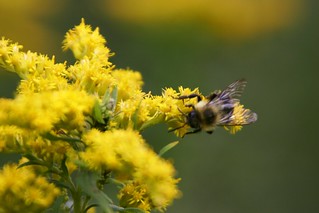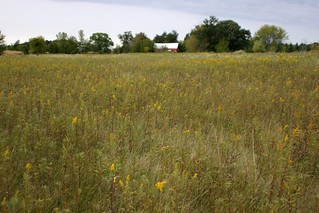Although there are still some plants that have the bright color, most of the goldenrod is now past its prime.
Nonetheless, it was a timely study since a good percentage of our farm has goldenrod. The picture below was taken on September 13, 2007 and shows a view from the southern part of the farm looking north towards the barn (white roof) and the house (in the trees to the right side of the barn and further north).
The goldenrod can be seen among the various types of grasses and weeds that are in the part of the farm that we've let remain natural.
There are flowers which live in villages and cities, but people who also live in villages and cities are so [foolish] that they hardly know a flower city when they see it .... [Today we went out to the pasture and visited] a golden city where the people are all dressed in yellow and where they live together in families; and the families all live on top of their little, green, singled houses, which are set in even rows along the street.
In each of these families, there are some flowers whose business it is to furnish nectar and pollen and to produce fruits which have fuzzy balloons; while there are other flowers in each family which wave yellow banners to all the insects that pass by and signal them with a code of their own.
There are many types of insects that visit goldenrod: honeybees, bumblebees, mining and carpenter bees, blue black blister beetles, chalcid flies, soldier beetles, and many others.
There are 56 types of goldenrod.
We also talked about the insect galls on goldenrod. If there is a hole in the gall, the insect has left. If there isn't a hole, then the insect is still inhabiting it.
After we learned a bit about goldenrod, we went outside for a walk along the street (the northwest part of the farm), through the backyard, and into the east pasture.
Some of the trees have changed colors while other ones are in the process of changing.
The field across the street is turning shades of gold and brown. The crops are almost ready to be harvested.
The girls found another wooly bear this week. There seems to be quite a few this year that we're spotting in the yard and crawling across the street.
The girls found another caterpillar on the deck and were surprised at how quickly it moved.
Olivia spotted a grasshopper that was in the pasture. It jumped a good couple of feet and landed next to the green plants...trying to blend in a bit.
We headed to the east pasture to take a closer at some of the goldenrod. We did find some areas where the goldenrod was still vividly colored.
In other areas, the goldenrod has started to fade and turn an off-shade of white. For comparison, there's a brighter section of goldenrod to the right of the photograph below.
We continued to walk through the pasture and Sophia pointed out a little area under the pine trees with some interesting mushrooms.
The picture below is blurry, but the mushroom was such an interesting one in shape and color.
Further back, there was yet another type of mushroom.
The sides and top were so different from one another.
The top was full of texture and beautiful shades of orange.
We looked at the back part of the property (this is looking southeast). If it were a couple of weeks earlier, the far back part would be all a golden color - it's mostly goldenrod interspersed in the grass.
This is another part of the back part of the farm, except looking east. All the tall pine trees are ones that we had transplanted. The willow tree and pine tree next to it we planted when they were less than eight feet tall.
The horses were walking with us. Hoss was interested in seeing the goldenrod that Olivia was holding.
Bailey just wanted to be next to Sophia. (Bailey is blind in her right eye and has a pigmentation issue in her left eye, yet knows the pasture and its layout so well she can gallop around it with Hoss.)
We spotted some more colorful goldenrod. There were some bees and a moth that were visiting the plants.
We turned around and Hoss was right there. Apparently he wanted to go on the nature walk as well.
There was an unexpected patch of wild daisies (or some type of wildflower) in the pasture.
When we came inside, the girls each did a page in their nature journal about goldenrod. Below is Sophia's nature journal entry.
Olivia's page is below.
It's been an interesting month of nature studies for us: blue jays, ants, milkweed/monarchs, and now goldenrod. Not only are we learning new information, but Sophia, Olivia, and I are getting outside and enjoying the many changes around the farm.
Spending time with the horses as well has been one of the highlights of our walks - not only for us, but I believe for Bailey and Hoss too!
Note: We used two posts on the Outdoor Hour Challenge as inspiration: OHC Goldenrod, Aster, and Chrysanthemum and Autumn Series: Goldenrod and Other Autumn Flowers.

























2 comments:
I had no idea there were so many kinds of goldenrod! Your land is wonderful! So much to see and investigate when the land is left natural like that. I have never seen a caterpillar jump! Cool! The horses had a good time, too. :)
We were surprised too, Rita, at the number of varieties of goldenrod. Thanks for the kind comment re: our land. That back part with all the goldenrod we are hoping to add tree seedlings this spring so essentially that back area will become more forested and provide better shelter and food for wildlife. I had to laugh when I read about the caterpillar jumping. I realized I made an error - it should have been a grasshopper jumping...not caterpillar. Thanks for pointing that out (I changed it so there's no future confusion when others read it.)
Post a Comment